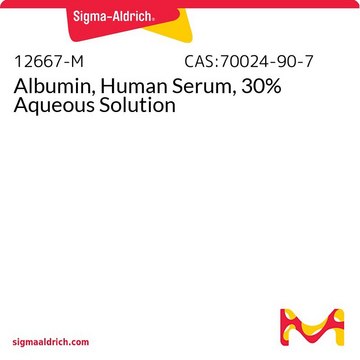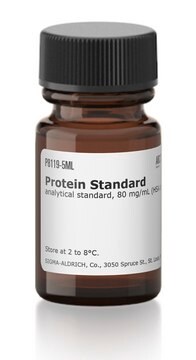A9080
Albumin solution human
30% in 0.85% sodium chloride, protease free
Synonym(s):
HSA
Sign Into View Organizational & Contract Pricing
All Photos(1)
About This Item
Recommended Products
biological source
human
Quality Level
form
liquid
concentration
29.5-35.0% protein (biuret)
30% in 0.85% sodium chloride
technique(s)
ELISA: suitable
tissue culture: suitable
western blot: suitable
impurities
HIV I and HIVII, HCV and HBsAg, tested negative
UniProt accession no.
storage temp.
2-8°C
SMILES string
FC(F)(F)C(F)(F)C(F)(F)F
InChI
1S/C3F8/c4-1(5,2(6,7)8)3(9,10)11
InChI key
QYSGYZVSCZSLHT-UHFFFAOYSA-N
Gene Information
human ... ALB(213)
Looking for similar products? Visit Product Comparison Guide
General description
Albumin is the most copious protein in blood plasma. Liver produces human albumin. Human serum albumin undergoes three different post-translational modifications: oxidation, glycation, and S-nitrosylation. Modifications usually occur on the surface of the globular protein, and do not significantly affect conformation. However, modification strongly affects binding of fatty acids and drug molecules.
Human serum albumin undergoes three different post-translational modifications: oxidation, glycation, and S-nitrosylation. Modifications usually occur on the surface of the globular protein, and do not significantly affect conformation. However, modification strongly affects binding of fatty acids and drug molecules.
Other Notes
View more information on human serum albumin.
Disclaimer
RESEARCH USE ONLY. This product is regulated in France when intended to be used for scientific purposes, including for import and export activities (Article L 1211-1 paragraph 2 of the Public Health Code). The purchaser (i.e. enduser) is required to obtain an import authorization from the France Ministry of Research referred in the Article L1245-5-1 II. of Public Health Code. By ordering this product, you are confirming that you have obtained the proper import authorization.
Storage Class Code
10 - Combustible liquids
WGK
WGK 3
Flash Point(F)
Not applicable
Flash Point(C)
Not applicable
Choose from one of the most recent versions:
Already Own This Product?
Find documentation for the products that you have recently purchased in the Document Library.
Customers Also Viewed
Copper-binding properties of bovine serum albumin and its amino-terminal peptide fragment.
T Peters et al.
The Journal of biological chemistry, 242(7), 1574-1578 (1967-04-10)
A A Spector et al.
Journal of lipid research, 10(1), 56-67 (1969-01-01)
We have studied the binding of long-chain free fatty acids (FFA) to crystalline bovine serum albumin (BSA) that had been extracted with charcoal to remove endogenous fatty acids. The data were analyzed in terms of a model consisting of six
T. Scott and M. Eagleson
Concise encyclopedia of biochemistry, 19-20 (1988)
Harald Olsen et al.
BMC clinical pharmacology, 4, 4-4 (2004-03-30)
Albumin is the most abundant protein in blood plasma, and due to its ligand binding properties, serves as a circulating depot for endogenous and exogenous (e.g. drugs) compounds. Hence, the unbound drug is the pharmacologically active drug. Commercial human albumin
Our team of scientists has experience in all areas of research including Life Science, Material Science, Chemical Synthesis, Chromatography, Analytical and many others.
Contact Technical Service



